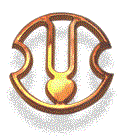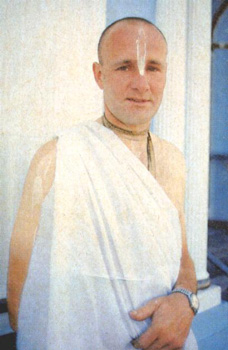![[Home Page]](../grfx/bml_logo.gif)

Vaisnava Saints Page
 On January 16,1967, Srila Prabhupada flew from New York to inaugurate the first Hare Krsna temple in San Francisco. His arrival was covered by the Channel Four news and by both daily newspapers. While most of San Francisco may have ignored the story, a young man named Jim Kohr noticed it. Despite having a degree in mechanical engineering from Ohio State University, he had been driving a taxi on the streets of San Francisco. Never quite able to fit into the corporate rat-race or the upperclass crowd, he was often unhappy and didn't really know why. Though Jim was not a religious person, the article ignited a ray of hope in him. He resolved to check out the Indian Swami.
On January 16,1967, Srila Prabhupada flew from New York to inaugurate the first Hare Krsna temple in San Francisco. His arrival was covered by the Channel Four news and by both daily newspapers. While most of San Francisco may have ignored the story, a young man named Jim Kohr noticed it. Despite having a degree in mechanical engineering from Ohio State University, he had been driving a taxi on the streets of San Francisco. Never quite able to fit into the corporate rat-race or the upperclass crowd, he was often unhappy and didn't really know why. Though Jim was not a religious person, the article ignited a ray of hope in him. He resolved to check out the Indian Swami.
Unknowingly, Jim was taking his first step toward fulfilling his destiny. Though he would live for only another ten years, in that short time he would witness the culmination of lifetimes of spiritual effort. He would depart the world leaving behind many valuable lessons to inspire and instruct present and future generations of Vaisnavas, devotees of the Lord.
The following evening, Jim arrived at the temple to find it filled mostly with hippies. With his short hair, cleancut looks, and well-pressed clothes, he stood out. And at 28, he was older than most of the others there. But Jim's misgivings disappeared when he saw the Swami enter. Jim sat through the lecture and bought a three-volume set of Srimad-Bhagavatam, which Srila Prabhupada autographed with the inscription "To Sriman Jim Kolr." For the first time in many years Jim felt peaceful. He had just received the audience of his eternal spiritual master.
Jim started coming to the temple regularly. He especially liked the morning program, when most of the hippies were still sleeping. Sometimes he would be the only person in the class. Years later he revealed that he trusted the Swami and felt confident the Swami wouldn't cheat him. As a four-year old, Jim had once stood up in church and looked around anxiously. When his grandmother had asked him what was the matter, he had asked, "Where is God" Now he felt that Srila Prabhupada was answering this ancient question buried deep in his consciousness. In February 1967, Prabhupada accepted Jim as his disciple and initiated him with the name Jayananda Dasa.
In Vaisnava scriptures, such as Srila Visvanatha Cakravarti Thakura's Madhurya-kadambini, we learn that a conditioned soul progresses through stages of sadhana-bhakti (devotional practice) before attaining spontaneous love for God. The new bhaktas (devotees) at the San Francisco temple would often struggle with their material desires and their daily spiritual practices, falling in and out of Krsna consciousness. Surprisingly, no one remembers Jayananda in the role of a "new bhakta". He took to Krsna consciousness naturally and effortlessly. He relished all aspects of Krsna consciousness-chanting on his beads, singing in kirtana, eating prasadam, performing Deity worship, and so on. He would often remark, 'Krsna consciousness is so sweet".
In fact, Jayananda found Krsna consciousness so sweet that he soon lost the taste for anything else. He gave his life savings to Srila Prabhupada, and in the Preface to The Nectar of Devotion, Prabhupada publicly thanked him: "I beg to acknowledge, with thanks, the contribution made by my beloved disciple Sriman Jayananda Brahmacari."
On the appearance day of Lord Caitanya, Srila Prabhupada was very pleased to see Jayananda spontaneously performing kirtana on the street outside the temple. Encouraged, Jayananda then started singing regularly on busier streets with other devotees, laying the foundation for chanting parties that would soon travel all over the country.
Both devotees and others were instinctively attracted by Jayananda's purity. Once, when he offered a garland to Srila Prabhupada, he apologized for his greasy clothes. Srila Prabhupada remarked, "There is absolutely no offence. You [my disciples] may be dirty, but your hearts are pure."
Jayananda touched the hearts of many people, and they usually responded by doing some service for Kr5na. He would get almost everything for the temple free or at a steep discount. He was friends with shopkeepers, city officials, drunks, and derelicts. Everybody loved Jayananda, and he happily engaged everyone in the service of the Lord. He worked the hardest, but he praised the service of everyone else. He was humble, tolerant, compassionate, and renounced. His actions, his words, his life, and his death all exemplified the process of bhakti, devotional service to the Lord.
Srila Prabhupada's instructions especially those encouraging practical service --became Jayananda's very life. Once, when a devotee asked him how to make advancement in Krsna consciousness, Jayananda shrugged and said, "I really don't know. I'm too busy working."
So immersed was Jayananda in executing Prabhupada's instructions that he would rarely get time to meet Srila Prabhupada. Serving in separation, he understood that association through instructions is more important than physical association. It is said that one must act in such a way that Krsna will want to see you; Jayananda exemplified this dictum by his service attitude.
Invariably Srila Prabhupada would ask for Jayananda, and someone would have to go fetch him. For Jayananda, Sri Krsna and Srila Prabhupada were the only two ultimate truths. Everything else, including his body, was to be engaged in their service.
Jayananda improved the festival year after year, raising money, getting permits, doing the publicity, building huge chariots from scratch, and even baking pies for groups he'd interact with, such as the city police and the U.S. Park Service. He would live with the chariots while they were being built, often working with little or no sleep as the festival date approached. Eventually held in Golden Gate Park, the festival drew bigger and bigger crowds year after year. Thanks to Jayananda's efforts, thousands of people received Lord Jagannatha's mercy. The festivals are now held in cities around the world.
Srila Prabhupada often expressed his deep gratitude to Jayananda for the festivals. When Jayananda passed away, Srila Prabhupada said that his picture should be carried on one of the chariots at every Rathayatra.
The New York Rathayatra was indeed a great success. Rolling down Fifth Avenue, the three chariots delighted thousands of people, many becoming inspired to inquire into and even take up the practices of Krsna consciousness. Srila Prabhupada was ecstatic. He called it a grand success and thanked Jayananda for his service.
The lumps on Jayananda's body turned out to be cancerous. He was diagnosed with leukaemia, which gradually reduced his body to a shell. Accepting that he would die soon, Jayananda continued to express his deep gratitude towards Srila Prabhupada. His friends were, shocked and saddened to see his disease-ravaged body, but Jayananda was still too busy, performing devotional service to give it much concern. Ane, when he did agree to medical treatment. he used his time in the hospital to tell doctors, nurses, and patients about Krsna consciousness.
Jayananda constantly thought about how to expand Rathayatra to other cities. In his final months, he helped organize the Los Angeles Rathayatra, making phone calls, raising money, and guiding devotees. One day, while walking on Venice Beach, here the festival would be held, he looked down and-as if visualizing the upcoming festival-said, "What a wonderful Rathayatra!"
On May 1, 1977, just a few months before the festival, Jayananda passed from this world. In a letter written to Jayananda after his passing, Srila Prabhupada congratulated him on a glorious life and an even more glorious death, since both in life and at death he had been absorbed in the service of Krsna. Prabhupada ordained that the disappearance day of Jayananda be celebrated like those of other Vaisnava saints. As Srila Bhaktivinoda Thakura so eloquently said:
He reasons ill who says thatAs I think about Jayananda, I imagine this scene: Somewhere an ISKCON Rathayatra is about to start. Conch shell blasts and cries of "Jaya Jagannatha!" pierce the sky. Looking on from the spiritual world, Jayananda turns to Srila Prabhupada, who nods and says, "Thank you very much".
Vaisnavas die
When thou art living still in sound!
The Vaisnavas die to live, and
living try
To spread the holy name around.
lesyndication.com/pagead/show_ads.js">